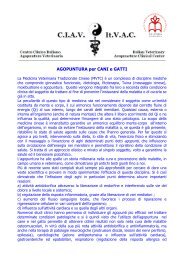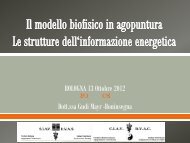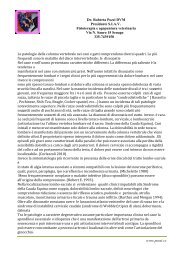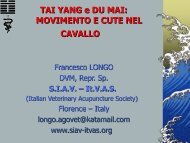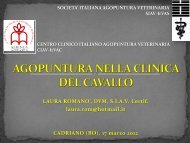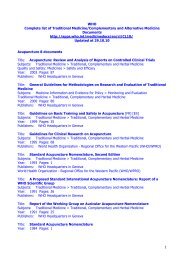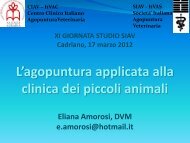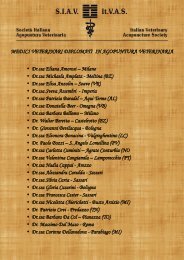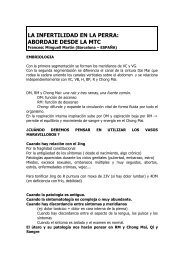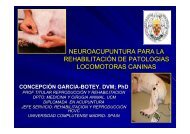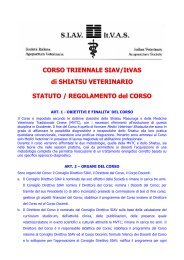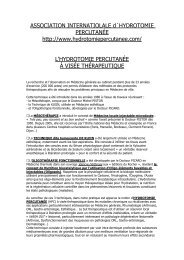ANME demands the recognition of Traditional Medicine ... - SIAV
ANME demands the recognition of Traditional Medicine ... - SIAV
ANME demands the recognition of Traditional Medicine ... - SIAV
You also want an ePaper? Increase the reach of your titles
YUMPU automatically turns print PDFs into web optimized ePapers that Google loves.
<strong>ANME</strong> <strong>demands</strong> <strong>the</strong> <strong>recognition</strong> <strong>of</strong> <strong>Traditional</strong> <strong>Medicine</strong> /<br />
CAM as an „Intangible Cultural Heritage“ - ICH<br />
Human evolution is not conceivable without cultural achievements. This cultural<br />
legacy is so far expressed by art, fashion, music, healing arts or <strong>the</strong> skill <strong>of</strong> cooking.<br />
Likewise <strong>the</strong> not yet tangible knowledge about plants, spiritual practices, dances and<br />
ritual correlations does belong to it as <strong>the</strong> so-called “Intangible Cultural Heritage“.<br />
<strong>Traditional</strong> medicine has its own cultural roots which are in parts thousands <strong>of</strong> years<br />
old and continue still intensely in all continents <strong>of</strong> this planet.<br />
According to <strong>the</strong> statutes <strong>of</strong> <strong>ANME</strong> all category <strong>of</strong> natural medicine has to be considered<br />
as traditional cultural heritage and which is property <strong>of</strong> mankind. Therefore is it<br />
utterly required to protect this inheritance in future as faithfully as possible for all<br />
European citizens and active CAM-practitioners in Europe.<br />
This means:<br />
1. A separate article has to be stipulated regarding ICH in <strong>the</strong> new directive about<br />
“patient’s rights”:<br />
“Today and in future each patient in Europe and each member<br />
state has <strong>the</strong> right to claim traditional/CAM methods in its original<br />
context as an Intangible Cultural Heritage.”<br />
2. Fur<strong>the</strong>rmore has to be stipulated ano<strong>the</strong>r separate article which incorporate <strong>the</strong><br />
application <strong>of</strong> ICH in <strong>the</strong> regulations <strong>of</strong> active CAM-pr<strong>of</strong>essionals<br />
“Practitioners <strong>of</strong> traditional/CAM methods Europe are <strong>the</strong> keepers<br />
<strong>of</strong> this Intangible Cultural Heritage and have <strong>the</strong> freedom to apply<br />
this legacy today and in future.”<br />
Schoeneck, 19th <strong>of</strong> February, 2009<br />
This is established by:<br />
1. NATIONAL AGENCY FOR THE INTANGIBLE CULTURAL HERITAGE<br />
Research project by UNESCO Austria in cooperation with <strong>the</strong> Austrian Federal<br />
Ministry for Health (2006 - 2010) according to <strong>the</strong> UNESCO Conventions <strong>of</strong> in<br />
2003 and 2005
Project „Safeguarding <strong>Traditional</strong> Remedies“<br />
In view <strong>of</strong> <strong>the</strong> EU-DIRECTIVE 2001/83/EC, Austrian law experienced an amendment<br />
to that effect that simplified admitted remedies should be unilaterally deleted without<br />
substitution from April 2011.<br />
In spite <strong>of</strong> a new EU-DIRECTIVE in 2004 which provided again a facilitated registration,<br />
<strong>the</strong> hurdles in <strong>the</strong> area <strong>of</strong> manufacturing procedure, standardisation and <strong>demands</strong><br />
for product-stability had become so high, that many remedies and drugs used<br />
in traditional/CAM-medicine well be unable to overcome <strong>the</strong>m.<br />
The Austrian National Agency for <strong>the</strong> Intangible Cultural Heritage has been involved<br />
within <strong>the</strong> scope <strong>of</strong> <strong>the</strong> UNESCO convention to <strong>the</strong> preservation <strong>of</strong> <strong>the</strong> Intangible<br />
Cultural Heritage regarding traditionally used remedies which run <strong>the</strong> risk by legal<br />
regulations not to sustain or achieve <strong>the</strong> status <strong>of</strong> a registered and admitted remedy<br />
from 2011. In particular for <strong>the</strong> purposes <strong>of</strong> a quality assurance <strong>the</strong> traditional remedies<br />
should be preserved from disappearing into a twilight-zone <strong>of</strong> dietary supplements.<br />
For this reason, a working group was established to develop quality criteria by means<br />
<strong>of</strong> monographs for <strong>the</strong> Austrian pharmacopoeia which already has taken up her activity<br />
in cooperation with university institutes and experts.<br />
Project „Collecting complementary and traditional healing methods in Austria”<br />
by Mrs. Mag. Michaela Noseck<br />
CAM-treatments are becoming increasingly popular. The WHO reports in <strong>Traditional</strong><br />
<strong>Medicine</strong> Strategy in 2002-2005 about a growing use <strong>of</strong> CAM-methods in industrialized<br />
countries. Due to <strong>the</strong> big number <strong>of</strong> “Energetiker” and <strong>the</strong> existence <strong>of</strong> CAM-<strong>of</strong>fers<br />
in <strong>the</strong> medias, an increase <strong>of</strong> CAM-treatments is assumed as well in Austria.<br />
<strong>Traditional</strong> remedial knowledge includes a big potential for public health care. The<br />
preservation and use <strong>of</strong> this information could add a lot <strong>of</strong> benefit to public health.<br />
The promotion <strong>of</strong> security, effectiveness and quality <strong>of</strong> CAM-methods and remedies<br />
should be a required condition. Dissemination and access to this knowledge ought be<br />
made easier.<br />
That's why on <strong>the</strong> part <strong>of</strong> The National Agency for <strong>the</strong> Intangible Cultural Heritage a<br />
research project was initiated which is promoted by <strong>the</strong> Federal Ministry <strong>of</strong> Health,<br />
Family and Youth as well as by a private assurance. Within <strong>the</strong> scope <strong>of</strong> <strong>the</strong> project it<br />
is foremost to clarify what can be considered as a <strong>Traditional</strong> Healing Knowledge in<br />
Austria. Subsequently one has to pursue <strong>the</strong> question in which areas <strong>of</strong> life and related<br />
specific problems, traditional/CAM knowledge can be relevant for modern citizens.<br />
Ano<strong>the</strong>r main focus <strong>of</strong> <strong>the</strong> project might be <strong>the</strong> clearing up <strong>of</strong> compatibility between<br />
CAM- and biomedical methods.<br />
The exact description <strong>of</strong> <strong>the</strong> particular CAM-<strong>the</strong>rapies belongs also to <strong>the</strong> specific<br />
aims <strong>of</strong> this project. The methods are assigned to categories, in order to get a systematic<br />
overview.<br />
Fur<strong>the</strong>rmore criteria concerning seriousness and security will be developed for <strong>the</strong><br />
sake <strong>of</strong> create <strong>the</strong> requirements for later evaluations.<br />
Additionally, an archive will be established for <strong>the</strong> documented findings <strong>of</strong> <strong>Traditional</strong>/CAM-methods.<br />
Knowledge is made available to <strong>the</strong> public by publications and<br />
by means <strong>of</strong> an own homepage which will be released. The target groups are on <strong>the</strong><br />
one hand <strong>the</strong> patients in order to facilitate <strong>the</strong>ir possibilities in decision-making, and
on <strong>the</strong> o<strong>the</strong>r hand <strong>the</strong> doctors who acquire information on additional treatments <strong>of</strong><br />
<strong>the</strong>ir patients.<br />
2. UNESCO:<br />
CONVENTION FOR THE SAFEGUARDING OF THE INTANGIBLE CULTURAL<br />
HERITAGE<br />
The general Conference <strong>of</strong> <strong>the</strong> United Nations Educational, Scientific and Cultural<br />
Organization hereinafter referred to as UNESCO, meeting in Paris, from 29th <strong>of</strong><br />
September to 17 October in 2003, at its 32nd session<br />
Article 17 – cunning <strong>of</strong> Intangible Cultural Heritage in Need <strong>of</strong> Urgent Safeguarding<br />
1. With a view to taking appropriate safeguarding measures, <strong>the</strong> Committee shall<br />
establish, keep up to date and publish a cunning <strong>of</strong> Intangible Cultural Heritage in<br />
Need <strong>of</strong> Urgent Safeguarding, and shall inscribe search heritage on <strong>the</strong> cunning at<br />
<strong>the</strong> request <strong>of</strong> <strong>the</strong> State party concerned.<br />
2. The Committee shall draw up and submit to <strong>the</strong> general Assembly for approval <strong>the</strong><br />
criteria for <strong>the</strong> establishment, updating and publication <strong>of</strong> this cunning.<br />
3. In cases <strong>of</strong> extreme urgency – <strong>the</strong> objective criteria <strong>of</strong> which shall be approved by<br />
<strong>the</strong> general Assembly upon <strong>the</strong> proposal <strong>of</strong> <strong>the</strong> Committee – <strong>the</strong> Committee may inscribe<br />
in item <strong>of</strong> <strong>the</strong> heritage concerned on <strong>the</strong> cunning mentioned in paragraph 1, in<br />
consultation with <strong>the</strong> State party concerned.<br />
Article 18 – programme, projects and activities for <strong>the</strong> safeguarding <strong>of</strong> <strong>the</strong> intangible<br />
cultural heritage<br />
1. On <strong>the</strong> basis <strong>of</strong> proposals submitted by States parties, and in accordance with criteria<br />
to be defined by <strong>the</strong> Committee and approved by <strong>the</strong> general Assembly, <strong>the</strong><br />
Committee shall periodically select and nationwide promotes, sub on <strong>the</strong> regional<br />
level and on <strong>the</strong> regional level programmes, projects and activities for <strong>the</strong> safeguarding<br />
<strong>of</strong> <strong>the</strong> heritage which it considers best <strong>of</strong> all reflect <strong>the</strong> principles and objectives<br />
<strong>of</strong> this Convention, taking into account <strong>the</strong> special needs <strong>of</strong> developing countries.<br />
2. To this, it shall receive, examine and approve requests for internationally assistance<br />
from States parties for <strong>the</strong> preparation <strong>of</strong> look proposals.<br />
3. The Committee shall accompany <strong>the</strong> implementation <strong>of</strong> look projects, programmes<br />
and activities by disseminating best <strong>of</strong> all practices using means to be determined by<br />
it.<br />
3. WHO:<br />
Beijing Declaration<br />
Adopted by <strong>the</strong> WHO Congress on <strong>Traditional</strong> <strong>Medicine</strong>, Beijing, China, 8th <strong>of</strong> November,<br />
2008:<br />
IV. <strong>Traditional</strong> medicine should be fur<strong>the</strong>r developed based on research and innovation<br />
in line with <strong>the</strong> "Global strategy and plan <strong>of</strong> action on public health, innovation<br />
and intellectual property" adopted at <strong>the</strong> Sixty ridge World Health Assembly in
esolution WHA61.21 in 2008. Governments, internationally organisations and o<strong>the</strong>r<br />
stakeholders should collaborate in implementing <strong>the</strong> worldwide strategy and flat <strong>of</strong><br />
action.<br />
SIXTY RIDGE WORLD HEALTH ASSEMBLY WHA61.21<br />
Agenda item 11.6 24 May in 2008<br />
"Global strategy and plan <strong>of</strong> action on public health, innovation and intellectual property"<br />
Espec.: Art.2.1, 2.2 and 3. + annex: 4.; 7.; 8. and 10:<br />
The Universally Declaration <strong>of</strong> Humanly Rights provides that "everyone has <strong>the</strong> right<br />
freely to participate in <strong>the</strong> cultural life <strong>of</strong> <strong>the</strong> community, to enjoy <strong>the</strong> arts and to share<br />
in scientific advancement and its benefits" and that "everyone has <strong>the</strong> right to <strong>the</strong><br />
protection <strong>of</strong> <strong>the</strong> moral and material interests resulting from any scientific, literary or<br />
artistic production <strong>of</strong> which he is <strong>the</strong> author".



